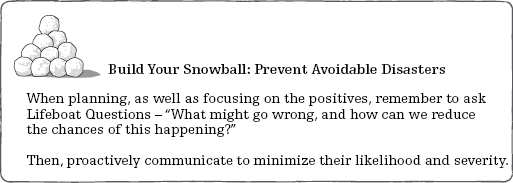62
When you want to prevent avoidable disasters
The Titanic sank about 100 years ago.
Imagine you’d been working for the shipping company White Star Line then, and were making your final preparations for the maiden voyage. All that excitement, pride and focus.
Sadly, in all the excitement about the positives, they didn’t prioritize the negatives. After all, if the voyage had been a success, nobody would have celebrated there being lots of lifeboats.
Communication can be like this. When working on projects, strategies and initiatives, in all the excitement, people often forget to ask Lifeboat Questions, such as:
- Why won’t this project be a success? How should we communicate, to ensure that it is?
- Which people will make or break this initiative? How should we communicate, to ensure they make it?
- Who might rebel against this strategy? How should we communicate, to pre-empt and remove their concerns?
- Which people are most worried about the outcome of this project? How should we communicate to reassure them, rather than wait until they start panicking?
When companies ask me to create communications to help initiatives succeed, my first questions always establish their desired outcome – What do you want to achieve? How will you know you’ve done so? And so on. People are usually pretty clear on their answers to these.
But my second questions always seek to establish what might go wrong – the Lifeboat Questions. This time, in response they usually say, “Good question. I haven’t thought about that”.
But it’s critical. For instance, my asking these questions unearthed such information as:
- The Board member who realized her presentation about the year’s new initiatives would have disengaged her already-overworked team.
- The company who realized that their new venture’s success/failure depended on how assiduously their managers changed their habits and followed up. But their planning hadn’t even considered these managers.
- The multinational company that realized the launch of its new service was going to antagonize virtually their entire salesforce, so much so that they wouldn’t want to sell it.
Once you’ve identified potential problems, proactively eliminate them.
The weird thing with this is that, when things subsequently run smoothly, nobody celebrates the fact you averted disaster. It never even became an issue.
But, on balance, I’ve found that most people prefer to have enough Lifeboats.

